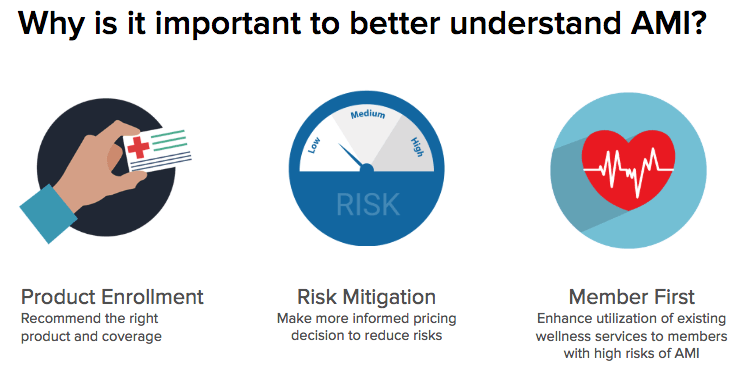Student Research | AMI (Heart Attack) Likelihood Prediction Analysis
By Jamie Chen, Johnny Chiu, and Junxiong Liu, all Class of 2018
This excerpt is taken from an MSiA student research blog posting. Each month, students in our program submit original extracurricular research as part of our blog competition. The winner(s) are published to the MSiA Student Research Blog, our program website, and receive a chance to attend an analytics conference of their choice. Visit our blog to see more.
Introduction
Hackathons and case competitions are great ways to test our knowledge by applying it to real-world problems, and this fall, our team (J-crew) participated in the 2018 Humana-Mays Healthcare Analytics Case competition that was open to all students pursuing Master’s degrees in the US. We were ecstatic when we were notified that our report was selected among the top five finalists from a pool of 246 teams from 42 major universities and that we were invited to the final presentation in Texas. We have extracted insights and designed modeling methods that closely aligned with business needs, built healthcare domain knowledge along the way, and learned from other finalists on creative problem-solving.
Case background
Heart disease remains the No.1 cause of deaths in the US. In 2016, heart disease cost America $555 billion, and this number is forecasted to reach $1.1 trillion by year 20351. The goal of the analysis was to help Humana better understand members’ likelihood of Acute Myocardial Infarction (AMI), also known as heart attack, through predictive modeling and establishing key indicators to inform Humana’s business decisions.
To come up with insights that are closely tailored to Humana’s business needs, we first spent time researching on Humana’s business and studied the company’s 2017 Annual Report. As a leading provider of Medicare Advantage plans, Humana received more than 90% of annual revenue from members’ premiums. More than half of Humana’s members enrolled in medical benefit plans and the remaining enrolled in specialty products. Given the high cost of AMI treatment, the ability to identify members with high risks of being diagnosed with AMI will help inform Humana’s pricing decision and allow Humana to provide preventative treatments in advance to target members, thus increasing premium revenue and reducing benefits expenses.
Source 1: American Heart Association Heart Disease and Stroke Statistics 2017 Report

Dataset and Preprocessing
To perform this analysis, we were given a dataset with 100,000 records, with each record corresponding to a member that continued their enrollment in Humana’s Medicare Advantage plan in 2016 and with no indication of AMI. Each member had 448 features, which contained information about member characteristics, product characteristics, quality of medication and utilization of plan. The response variable was AMI_flag, indicating whether the member was diagnosed with AMI in the first quarter of 2017.


